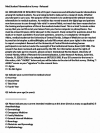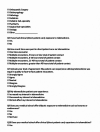Awareness and Attitudes Towards Telemedicine Among Medical Students in the United States
- PMID: 33364099
- PMCID: PMC7749854
- DOI: 10.7759/cureus.11574
Awareness and Attitudes Towards Telemedicine Among Medical Students in the United States
Abstract
Introduction: Telemedicine (TM) or telehealth is defined as the delivery of healthcare services at a distance using electronic means. It is a rapidly growing field of medicine that uses telecommunication to provide healthcare services to patients such as the elderly and those in rural locations who may otherwise be unable to make it to the hospital or physician's office. With the rise in the popularity of TM, educating future physicians on this technology will become vital. This study aimed to explore medical students' experiences and opinions regarding TM.
Methods: An online survey was sent to 287 medical students in 20 different allopathic medical schools in the United States. The survey consisted of 14 questions that included demographic information, information regarding TM exposure, interest in TM, and plans for future utilization.
Results: The result of this study indicated that only 17.4% of medical students had prior exposure to TM. However, the increased exposure to TM helped not only to increase awareness of the technology but also helped students form opinions on TM. Lastly, students in all intended specialties had interests in utilizing TM in the future with specialties such as pathology, psychiatry, ophthalmology, and dermatology indicating the highest levels of interest.
Conclusion: As medicine continues to incorporate technology into the care of patients, training institutions need to expose future physicians to the modalities of care they will be utilizing. The results of this survey suggest that the development of education and exposure to TM will become increasingly important as more medical students indicate interest in utilizing this technology.
Keywords: medical education; medical student; telehealth; telemedicine.
Copyright © 2020, Kong et al.
Conflict of interest statement
This research was supported (in whole or in part) by HCA Healthcare and/or an HCA Healthcare-affiliated entity. The views expressed in this publication represent those of the author(s) and do not necessarily represent the official views of HCA Healthcare or any of its affiliated entities.
Figures
References
-
- History of telemedicine: evolution, context, and transformation. Ryu S. Healthc Inform Res. 2010;16:65–66.
-
- Percentage of U.S. patients that continued with telemedicine after their initial visit 2017. [Mar;2020 ];https://www.statista.com/statistics/870017/patients-continuing-telemedic... 2017
-
- Projected number of telehealth patients worldwide from 2013 to 2018. [Mar;2020 ];https://www.statista.com/statistics/302641/global-telehealth-market-pati... 2018
-
- Training the next generation of care providers: focus on telehealth. Papanagnou D, Sicks S, Hollander J. Healthc Transform. 2015;1:52–63.
LinkOut - more resources
Full Text Sources
Research Materials



